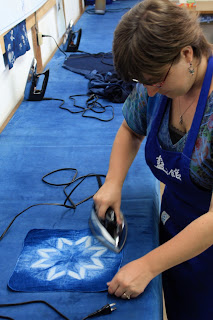Take a strip of cloth, tie a few knots in it, dip, and rinse.
Ummm .... I can do that at home without having to spend twenty dollars on bus fare.
Never mind that I haven’t ever done it at home, nor would have I thought of doing it at home. Indigo dyeing is a traditional Japanese craft best experienced in a room full of midnight-coloured vats, the smell overpowering all my good sense.
And then I realise, no - I couldn’t have done this at home. This is not commercial Rit Dye, this is the real stuff: made from fermented indigo leaves and lye and bits of various plant materials. It is dark, bubbly, deep, and it stinks (one website diplomatically calls the smell “distinctive” Umm, yes, that’s it...distinctive).
The dyeing was a lot of fun, so much so that I went back twice. Okay, we had mistakenly brought three cloths along to dye, and also had two hours until our next bus, but it was, indeed, a lot of fun.

The museum itself comprises four buildings edging a courtyard. In one long, dark building, small models of the indigo making process leads visitors on a tour from planting the seeds, through harvest, dye making, and dying cloth, and finally into the store for sale.
Tools occupied one building: including traditional leaf-gathering baskets and old vats and various leaf grinding machines.
The house of an indigo merchant is preserved for visitors to walk though. It is currently empty of all furnishings save one lone mannequin of an accountant taking notes of the indigo stock, but the house itself is full of rich details: Painted screens on closet doors and intricate woodwork almost impossible to photograph; light fixtures both western and Japanese; traditional tatami rooms surrounded by a wooden veranda; three sets of stairs led us us through a maze of rooms and hallways.





Even empty, there is a lot to see.
 |
| Stencil from the of Days of Yore. |











I learned that dyeing (though maybe not quite as fun as glass blowing) is still very fun.
No comments:
Post a Comment